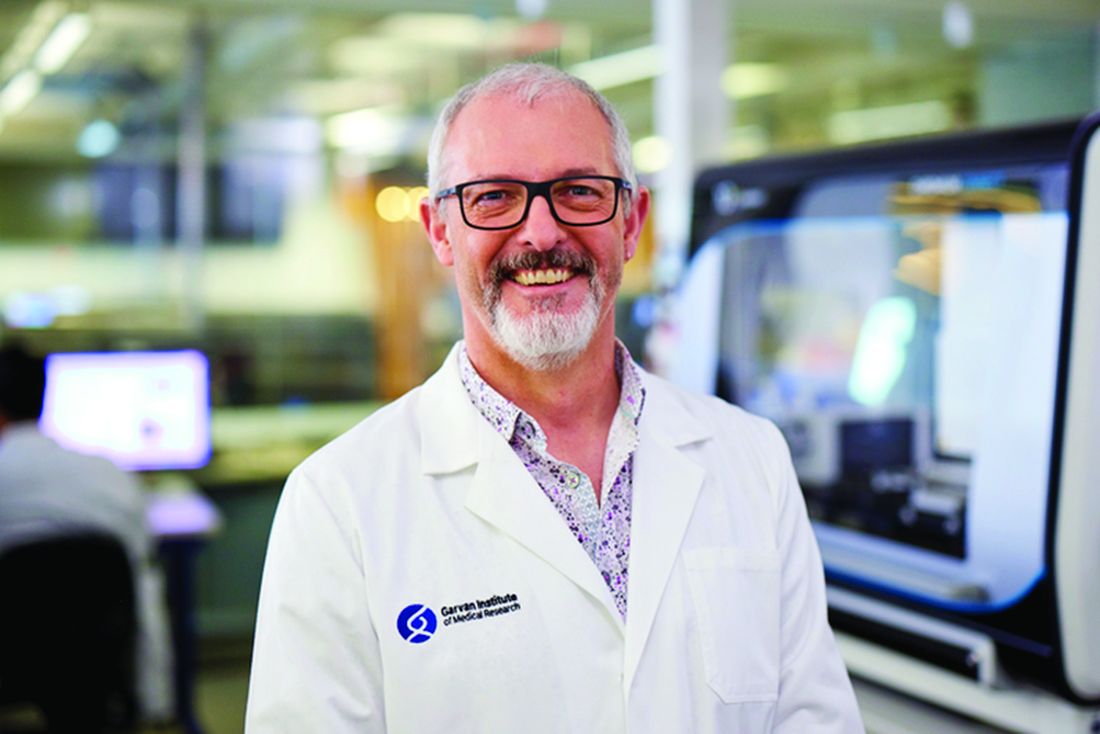User login
Increased core body temperature is a likely trigger of disease flares in the rare genetic autoinflammatory disorder mevalonate kinase deficiency (MKD), based on a study involving new mouse models.
The study also uncovered potential strategies for treating MKD, lead author Marcia A. Munoz, PhD, of the Garvan Institute of Medical Research and the University of New South Wales, Sydney, and colleagues reported in Journal of Clinical Investigation.
“MKD encompasses a severe manifestation – mevalonic aciduria, and a milder form – a periodic fever syndrome known as hyperimmunoglobulinemia D syndrome,” the investigators wrote.
They noted that severity inversely correlates with the amount of mevalonate kinase in the body. To date, however, it’s been unclear why reduced levels of the enzyme lead to inflammation, or exactly how body temperature plays a role in this process, despite observations that disease flares can be triggered by temperature-raising activities like strenuous exercise.
“The underlying disease mechanisms in MKD have been very difficult to elucidate, because newly identified patients are usually young children (and it’s very difficult to obtain any samples of tissues or cells other than small samples of blood), and also because until now there were no laboratory models that truly mimic the human disease,” senior author Michael J. Rogers, PhD, of the Garvan Institute said in a written comment.
Dr. Rogers and colleagues addressed this gap by creating the first murine models to carry the relevant mutant allele in MVK, the gene encoding mevalonate kinase. These mice had lower levels of the enzyme, which led to increased levels of mevalonic acid and defects in protein prenylation (the addition of hydrophobic moieties), the latter of which were significantly associated with inflammation.
“The discovery that shortage of geranylgeranyl diphosphate, the substrate necessary for prenylation of over 300 substrates including small GTPases, and not the elevated mevalonic acid levels, correlated with inflammation was an important finding that ultimately provided a pathomechanism that linked the mevalonate kinase deficiency to inflammasome activation,” said Raphaela T. Goldbach-Mansky, MD, chief of the translational autoinflammatory disease studies unit at the National Institute of Allergy and Infectious Diseases.
Dr. Goldbach-Mansky said the new mouse models can serve as “preclinical platforms” to test the efficacy and safety of possible treatments, such as supplementing geranylgeraniol, an intermediate product in the mevalonate pathway, or blocking NLRP3, the inflammasome in question.
While both of these interventions showed efficacy in mice, it is unclear whether the same therapies will work in people, as the models may not reflect all human disease characteristics.
“It remains unclear which human features are modeled in the mouse model,” Dr. Goldbach-Mansky said, noting that humans may exhibit unique inflammasomes and disease triggers.
Dr. Rogers aims to find out. After 8 years of work that culminated in the present publication, he and his colleagues are now exploring ways of circumventing the defective enzyme to restore normal metabolism. He expects “many more years of work” to understand exactly how MKD affects the immune system and other organs, and how these processes can be mitigated.
Still, he is optimistic.
“Of the many autoinflammatory diseases that are known so far, we believe that new treatments are truly within reach to overcome MKD,” Dr. Rogers said.
The study was supported by the Australian National Health and Medical Research Council, St. Vincent’s Clinic Foundation, the Allergy and Immunology Foundation of Australasia, and others. The investigators and Dr. Goldbach-Mansky declared no competing interests.
Increased core body temperature is a likely trigger of disease flares in the rare genetic autoinflammatory disorder mevalonate kinase deficiency (MKD), based on a study involving new mouse models.
The study also uncovered potential strategies for treating MKD, lead author Marcia A. Munoz, PhD, of the Garvan Institute of Medical Research and the University of New South Wales, Sydney, and colleagues reported in Journal of Clinical Investigation.
“MKD encompasses a severe manifestation – mevalonic aciduria, and a milder form – a periodic fever syndrome known as hyperimmunoglobulinemia D syndrome,” the investigators wrote.
They noted that severity inversely correlates with the amount of mevalonate kinase in the body. To date, however, it’s been unclear why reduced levels of the enzyme lead to inflammation, or exactly how body temperature plays a role in this process, despite observations that disease flares can be triggered by temperature-raising activities like strenuous exercise.
“The underlying disease mechanisms in MKD have been very difficult to elucidate, because newly identified patients are usually young children (and it’s very difficult to obtain any samples of tissues or cells other than small samples of blood), and also because until now there were no laboratory models that truly mimic the human disease,” senior author Michael J. Rogers, PhD, of the Garvan Institute said in a written comment.
Dr. Rogers and colleagues addressed this gap by creating the first murine models to carry the relevant mutant allele in MVK, the gene encoding mevalonate kinase. These mice had lower levels of the enzyme, which led to increased levels of mevalonic acid and defects in protein prenylation (the addition of hydrophobic moieties), the latter of which were significantly associated with inflammation.
“The discovery that shortage of geranylgeranyl diphosphate, the substrate necessary for prenylation of over 300 substrates including small GTPases, and not the elevated mevalonic acid levels, correlated with inflammation was an important finding that ultimately provided a pathomechanism that linked the mevalonate kinase deficiency to inflammasome activation,” said Raphaela T. Goldbach-Mansky, MD, chief of the translational autoinflammatory disease studies unit at the National Institute of Allergy and Infectious Diseases.
Dr. Goldbach-Mansky said the new mouse models can serve as “preclinical platforms” to test the efficacy and safety of possible treatments, such as supplementing geranylgeraniol, an intermediate product in the mevalonate pathway, or blocking NLRP3, the inflammasome in question.
While both of these interventions showed efficacy in mice, it is unclear whether the same therapies will work in people, as the models may not reflect all human disease characteristics.
“It remains unclear which human features are modeled in the mouse model,” Dr. Goldbach-Mansky said, noting that humans may exhibit unique inflammasomes and disease triggers.
Dr. Rogers aims to find out. After 8 years of work that culminated in the present publication, he and his colleagues are now exploring ways of circumventing the defective enzyme to restore normal metabolism. He expects “many more years of work” to understand exactly how MKD affects the immune system and other organs, and how these processes can be mitigated.
Still, he is optimistic.
“Of the many autoinflammatory diseases that are known so far, we believe that new treatments are truly within reach to overcome MKD,” Dr. Rogers said.
The study was supported by the Australian National Health and Medical Research Council, St. Vincent’s Clinic Foundation, the Allergy and Immunology Foundation of Australasia, and others. The investigators and Dr. Goldbach-Mansky declared no competing interests.
Increased core body temperature is a likely trigger of disease flares in the rare genetic autoinflammatory disorder mevalonate kinase deficiency (MKD), based on a study involving new mouse models.
The study also uncovered potential strategies for treating MKD, lead author Marcia A. Munoz, PhD, of the Garvan Institute of Medical Research and the University of New South Wales, Sydney, and colleagues reported in Journal of Clinical Investigation.
“MKD encompasses a severe manifestation – mevalonic aciduria, and a milder form – a periodic fever syndrome known as hyperimmunoglobulinemia D syndrome,” the investigators wrote.
They noted that severity inversely correlates with the amount of mevalonate kinase in the body. To date, however, it’s been unclear why reduced levels of the enzyme lead to inflammation, or exactly how body temperature plays a role in this process, despite observations that disease flares can be triggered by temperature-raising activities like strenuous exercise.
“The underlying disease mechanisms in MKD have been very difficult to elucidate, because newly identified patients are usually young children (and it’s very difficult to obtain any samples of tissues or cells other than small samples of blood), and also because until now there were no laboratory models that truly mimic the human disease,” senior author Michael J. Rogers, PhD, of the Garvan Institute said in a written comment.
Dr. Rogers and colleagues addressed this gap by creating the first murine models to carry the relevant mutant allele in MVK, the gene encoding mevalonate kinase. These mice had lower levels of the enzyme, which led to increased levels of mevalonic acid and defects in protein prenylation (the addition of hydrophobic moieties), the latter of which were significantly associated with inflammation.
“The discovery that shortage of geranylgeranyl diphosphate, the substrate necessary for prenylation of over 300 substrates including small GTPases, and not the elevated mevalonic acid levels, correlated with inflammation was an important finding that ultimately provided a pathomechanism that linked the mevalonate kinase deficiency to inflammasome activation,” said Raphaela T. Goldbach-Mansky, MD, chief of the translational autoinflammatory disease studies unit at the National Institute of Allergy and Infectious Diseases.
Dr. Goldbach-Mansky said the new mouse models can serve as “preclinical platforms” to test the efficacy and safety of possible treatments, such as supplementing geranylgeraniol, an intermediate product in the mevalonate pathway, or blocking NLRP3, the inflammasome in question.
While both of these interventions showed efficacy in mice, it is unclear whether the same therapies will work in people, as the models may not reflect all human disease characteristics.
“It remains unclear which human features are modeled in the mouse model,” Dr. Goldbach-Mansky said, noting that humans may exhibit unique inflammasomes and disease triggers.
Dr. Rogers aims to find out. After 8 years of work that culminated in the present publication, he and his colleagues are now exploring ways of circumventing the defective enzyme to restore normal metabolism. He expects “many more years of work” to understand exactly how MKD affects the immune system and other organs, and how these processes can be mitigated.
Still, he is optimistic.
“Of the many autoinflammatory diseases that are known so far, we believe that new treatments are truly within reach to overcome MKD,” Dr. Rogers said.
The study was supported by the Australian National Health and Medical Research Council, St. Vincent’s Clinic Foundation, the Allergy and Immunology Foundation of Australasia, and others. The investigators and Dr. Goldbach-Mansky declared no competing interests.
FROM THE JOURNAL OF CLINICAL INVESTIGATION


